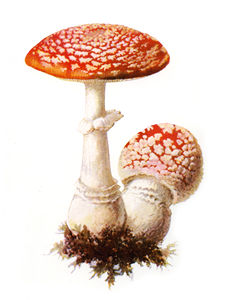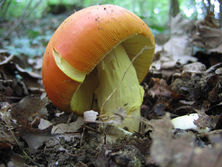Amanita
| Amanita | |
|---|---|
 |
|
| Amanita muscaria Albin Schmalfuß, 1897 |
|
| Scientific classification | |
| Kingdom: | Fungi |
| Subkingdom: | Dikarya |
| Phylum: | Basidiomycota |
| Subphylum: | Agaricomycotina |
| Class: | Agaricomycetes |
| Subclass: | Agaricomycetidae |
| Family: | Amanitaceae |
| Genus: | Amanita Pers. |
| Type species | |
| Amanita muscaria |
|
| Diversity | |
| c.600 species | |
| Synonyms | |
|
Aspidella |
|
The genus Amanita contains about 600 species of agarics including some of the most toxic known mushrooms found worldwide. This genus is responsible for approximately 95% of the fatalities resulting from mushroom poisoning, with the death cap accounting for about 50% on its own. The most potent toxin present in these mushrooms is α-amanitin.
The genus also contains many edible mushrooms, but mycologists generally discourage amateur mushroom hunters from selecting these for human consumption. Nonetheless, in some cultures, the larger local edible species of Amanita are mainstays of the markets in the local growing season. Samples of this are Amanita zambiana and other fleshy species in central Africa, A. basii and similar species in Mexico, A. caesarea in Europe, and A. chepangiana in South-East Asia. Other species are used for colouring sauces, such as the red A. jacksonii with a range from eastern Canada to eastern Mexico.
Many species are of unknown edibility, especially in countries such as Australia where many fungi are little-known. Understandably, this is not a genus that lends itself to safe experimentation.
Contents |
Taxonomy
The name is possibly derived from Amanon, a mountain in Cilicia.
The genus Amanita was first published with its current meaning by Christian Hendrik Persoon in 1797.[1] Under the International Code of Botanical Nomenclature, Persoon's concept of Amanita, with Amanita muscaria (L.) Pers. as the type species, has been officially conserved against the older Amanita Boehm (1760) which is considered a synonym of Agaricus L.[2]
Toxicity

Several members of the section Phalloidieae are notable for their toxicity, containing toxins known as amatoxins which can cause liver failure and death. These include the death cap A. phalloides, species known as destroying angels including A. virosa, A. bisporigera and A. ocreata and the fool's mushroom A. verna.
More recently, a series in the subgenus Lepidella have been found to cause acute renal failure, including A. smithiana of Northwestern North America, A. pseudoporphyria of Japan, and A. proxima of southern Europe.[3]
See also
- Destroying angel
- List of Amanita species
References
- ↑ Persoon, C.H. (1797) Tent. disp. meth. fung.: 65
- ↑ J. McNeill et al. (eds)(2006) International Code of Botanical Nomenclature (Vienna, 2005), Appendix IIIA Nomina generica conservanda et rejicienda, B. Fungi http://ibot.sav.sk/icbn/main.htm
- ↑ Saviuc P, Danel V (2006). "New Syndromes in Mushroom Poisoning". Toxicological Reviews 25 (3): 199–209. doi:10.2165/00139709-200625030-00004. PMID 17192123.
External links
- The Genus Amanita - AmericanMushrooms.com.
- Rodham E. Tuloss and Zhu-liang Yang's Amanita site – Comprehensive listing of the nearly 600 named Amanita species with photos and/or technical details on over 510 species.
- "The genus Amanita" by Michael Kuo, MushroomExpert.Com, March 2005.